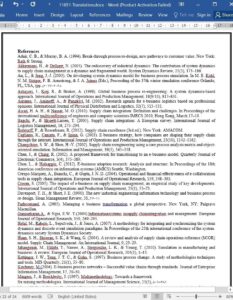Abstract
Although a number of methodologies exist for business process re-design (BPR), supply chain re-design (SCR), and e-business process design, there is a lack of an integrated BPR methodological framework to support supply chain integration (SCI). This paper proposes a detailed framework based on integrating a number of different methodological strands from the literature. A literature review was conducted in three different domains – business process re-design, supply chain re-design and e-business process design. The literature review revealed the potential for integrating elements of a number of different methods and techniques found in different methodological strands into a framework for conducting BPR to support SCI. Accordingly a number of relevant methodologies were identified, decomposed and compared at their stage and technique/method level to identify a combination for development of the integrated framework. The proposed BPR methodology can be applied in any company or sector; methods and techniques incorporated are not specific to any sector. The proposed BPR methodology proposed constitutes an aid for supply chain practitioners in the construction of SCI.
1. Introduction
1.1. Supply chain integration
The necessity to coordinate several business partners, internal corporate departments, business processes and diverse customers across the supply chain gave rise to the field of supply chain management (SCM), (Turban, King, Lee, Liang, & Turban, 2011). At the core of gaining competitive advantage through SCM is supply chain integration (SCI); when integration is achieved, the supply chain operates as a single entity driven directly by customer demand (Farhoomand, 2005). However the supply chain literature shows the existence of a number of challenges associated with the integration of supply chains (Awad & Nassar, 2010; Bagchi & Skjoett-Larsen, 2005; Sweeney, 2011). Among these challenges, sharing of information, coordination of physical good flows, and integration of business processes appear to be most critical(Prajogo & Olhager, 2012; Robertson, Gibson, & Flanagan, 2002; Sahin & Robinson, 2002).
4. Conclusions
Despite the potential benefits of e-business to supply chain management, the literature suggests a number of challenges preventing its successful adoption: in particular, the need to re-design business processes. A number of methodologies were found that address business process re-design, supply chain re-design, and ebusiness process design. However, none of these methodologies addressed, in particular, how to redesign business processes to support construction of supply chain integration. Through a literature review conducted in different domains, a methodology has been developed and proposed here to tackle this particular problem. For each one of the BPR methodology stages, relevant methods and techniques were reviewed from the literature, selected and combined. This is summarized in Fig. 13.











